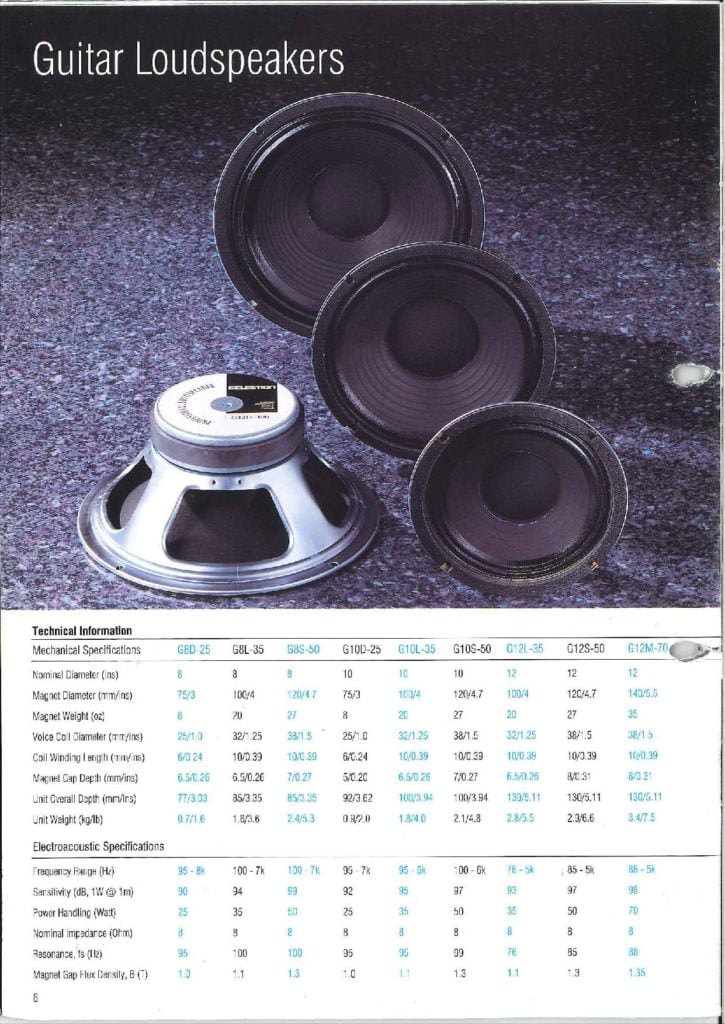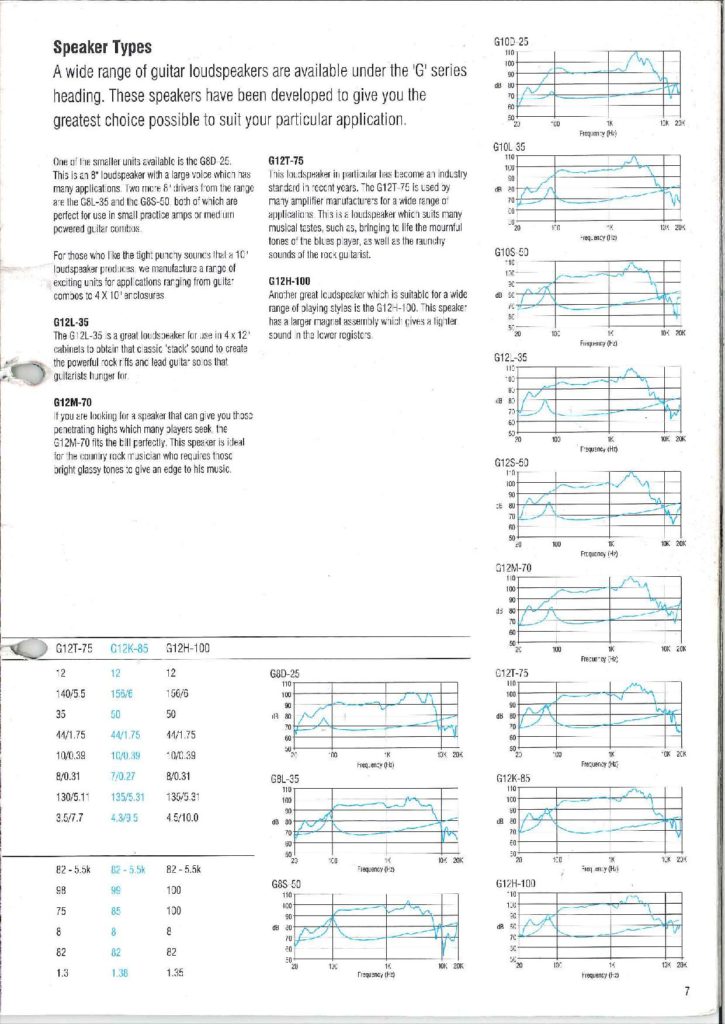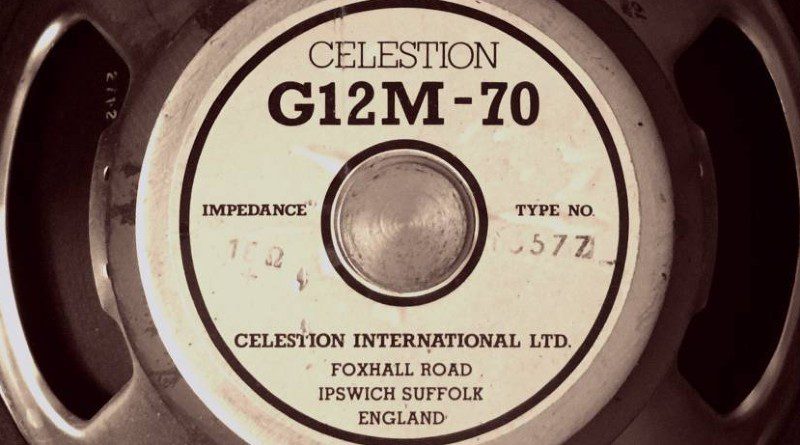Despite being from the same Celestion G12M family as the legendary Greenback and Creamback speakers, the G12M-70 is widely panned.
However, the G12M-70 does have some use cases worth considering. Many users say the otherwise bland and “beige carpet” speaker works well to tame an overly bright amp and warm up a brittle tone.
So if you find yourself with one or more hanging around, don’t throw them away yet, because you might just find they fit well with your existing guitar rig!
Interested in guitar speakers?
Check out our full rundown of the best guitar speakers.
Contents
The Classic Celestion G12M Family
Celestion’s G12M family of speaker has been around since the mid-’60s, with the most famous member being the Greenback.
Celestion G12M Greenback
This fan favorite started life as a 20-watt RMS power speaker before quickly finding it’s home as a 25-watt.
The Greenback got its name from the green plastic magnet cover. While this color did change throughout the ’70s (at different points beige, black, and many other colors), the speaker itself was largely unchanged until around 1979.
The speaker is voiced with a broad midrange attack with a somewhat rolled-off top end, which allows a forward, punchy attitude without causing any top-end fizz.
Celestion G12M Creamback
The Creamback came along much later on, 2011 in fact, and was created by Celestion to be a higher-powered, more modern version of the Greenback.
It has a vintage tone similar to the Greenback, but with an increased bottom end and a more pronounced shelf in the top end. In addition, it runs at 65 watts to the Greenback’s 25.
Enter the G12M-70
Now it’s been said by many that the G12M-70 is the worst speaker Celestion ever produced. And while beauty is in the eye of the beholder, Celestion did completely scrub this speaker from their website.
That said, there was a time in the ’80s when both Carvin and Marshall were using either G12M-70 speakers or in the case of Marshall, a branded Verion.
For years, Carvin was shipping four of these in their 4×12 cabs, with Marshall also shipping them in their JCM800 cabs and combos of the time.
It wasn’t just Carvin or Marshall. A lot of budget amps and cabs were shipping with the 70 or the G12T-75, which was massively popular at the time.
However, the G12M-70 eventually fell out of favor and stopped being manufactured.
Celestion G12M-70 Specs
I reached out to The Doc at Celestion who was kind enough to send me a few pages from a 1994 Celestion catalog.


They describe the G12M-70 as follows:
If you are looking for a speaker that can give you those penetrating highs which many players seek, the G12M-70 fits the bill perfectly. This speaker is ideal for the country rock musician who requires those bright glassy tones to give an edge to his music.
Mechanical Specifications
| Nominal Diameter (ins) | 12 |
| Magnet Diameter (mm/ins) | 140 / 5.5 |
| Magnet Weight (oz) | 35 |
| Voice Coil Diameter (mm/ins) | 38 / 1.5 |
| Coil Winding Lengths (mm/ins) | 10 / 0.39 |
| Magnet Gap Depth (mm/ins) | 8 / 0.31 |
| Unit Overall Depth (mm/ins) | 130 / 5.11 |
| Unit Weight (kg/lbs) | 3.4 / 7.5 |
Electroacoustic Specifications
| Frequency Range (Hz) | 88 – 5K |
| Sensitivity (dB, 1W @ 1m) | 98 |
| Power Handling (Watt) | 70 |
| Nominal Impedance (Ohm) | 8 |
| Resonance, fs (Hz) | 88 |
| Magnet Gap Flux Density, B (T) | 1.35 |
The Case Against the G12M-70
If you google the G12M-70, you’ll get thread after thread of people looking to swap out these speakers or opening a second-hand JCM800 crestfallen to find this lurking inside.
Common complaints are that it has a bland, woofy, flabby tone. Or that they’re good for leads, but lack power for full chords. Or that they’re somewhat flat, with a lack of bass, neutral highs, and lackluster mids. Others say the speaker has more emphasis in the upper mids than the Greenback or Creamback, which robs it of a smooth tone.
One thing to keep in mind however is that the G12M-70 is out of production, so many of the speakers floating around are likely nearing the end of their lives.
The Case for the G12M-70
All that being said, every speaker has its place, and while many complain the 70 has a bland tone, that does actually offer you some options.
First of all, these speakers work great with an amp that’s bright, brittle and overly trebley. The somewhat flat sound will even out all of those frequencies.
Indeed, various guitarists have mentioned having good experiences with pairing a G12M-70 with a ’77 Fender Twin Reverb to get a wonderful punchy clean sound.
Second, they are at home with a closed cabinet, possibly due to its effect on the bass response, clearing up some of that woofy tone others complain about.
Finally, the speaker is “correct” for an 800-amp design. The somewhat flat response gives you an excellent pallet to work your tone from scratch using the amp’s dials rather than it coming from the speaker.

Pairing a G12M-70 with Other Speakers
Probably the most popular use for the G12M-70 is pairing two in an X pattern with other speakers. Its flat tone can be used to offset a speaker with tons of character that you maybe want to rein back a little.
Celestion G12T-75
The most popular combo is the G12M-70 with the G12T-75. The crunch of the G12T-75 paired with the flatter G12M-70 gives a punchy but balanced tone. It also doesn’t hurt that the two are at very similar price points and vintages.
Alternatives
If you’re looking to replace a G12M-70… well, the world is your oyster!
Naturally Greenbacks and Creambacks would be the go-to, but let’s look at a few other options, from clean tones to mid-gain to thunderous chug.
Celestion G12K-100 – Best Clean Tone
Celestion really do make a speaker for every occasion and you can’t beat the G12K100 for an amazing clean tone at the right price.
Sure, you can go for the Electro-Voice EVM12L, but you’re into serious premium territory there. It’s the best, but you’re looking at a grand to populate a 412 cab.
With the G12k-100 you’re getting a massive bottom end, punchy midrange, and a restrained top end for half the price. Crisp, clean, smooth sound. Plenty of punch, low end, and not brittle upper.
Celestion Vintage 30 – Best Mid Gain
For the player who just wants a classic ’80s sound, the Vintage 30 was born. Back in 1986, as Van Halen were topping the charts, Celestion saw a gap in the market for a speaker capable of handling much more power and distortion than their existing lineup.
The new Vintage 30 filled that gap, giving a detailed sound, with a warm low end, vocal midrange, and detailed top end.
The speaker was of course an instant hit and went on to be the choice for players like Slash, Steve Stevens, and Peter Frampton. These days they’re the speaker of choice for many metal players when paired with an overdrive.
Eminance Patriot Swamp Thang – Best High Gain
The Swamp Thang is what you break out when you want to get heavy. This speaker provides a thick and chunky tone with a bucketload of sustain.
It also has a super tight low end that makes it a favorite of seven- and eight-string guitarists. It also has a great detailed top end with no fizz.
These also pair excellently with Vintage 30s, Governors, or other staples of the 412 cab world.
Final Thoughts on the Celestion G12M-70
The Celestion G12M-70 didn’t set the world on fire, but it’s not a bad speaker either. If you need to tame a brittle, overly bright amp, the G12M-70 is probably the speaker for you, especially at the current used market price. Otherwise, there are better options galore.
By the way, while you’re here you might be interested in checking out our articles on the best speakers for blues, best speaker cabs for modelling amps, along with our article on whether you need to burn in speakers. Enjoy!
Check out these other similar articles:


